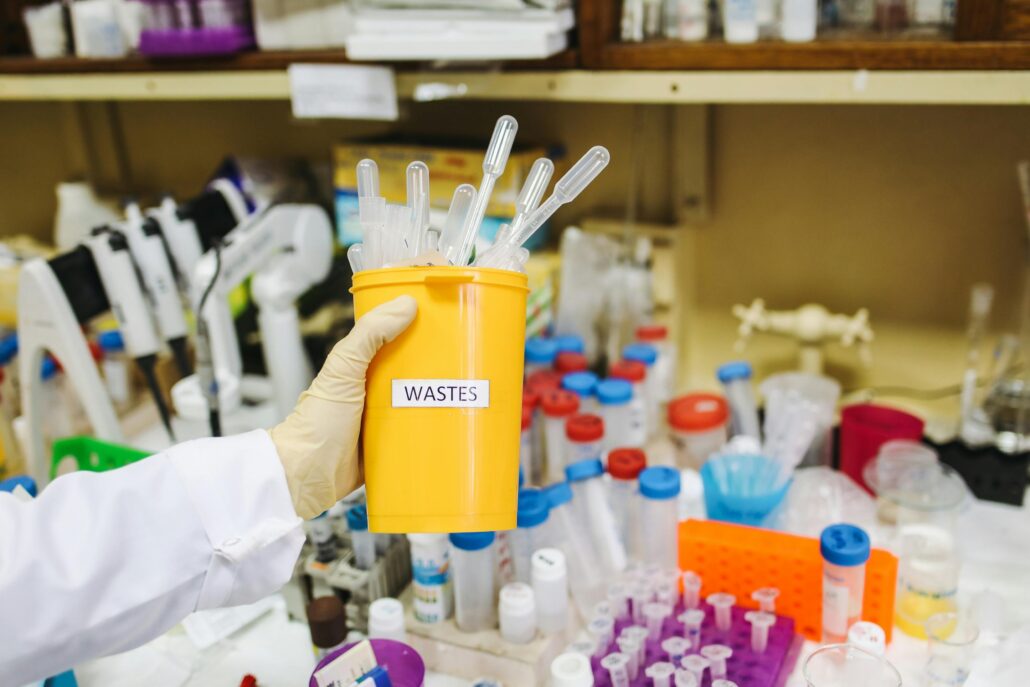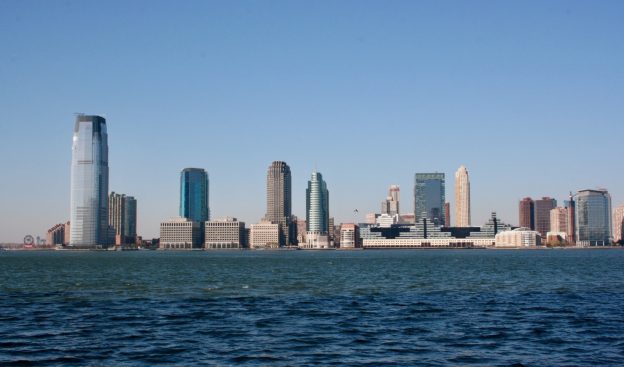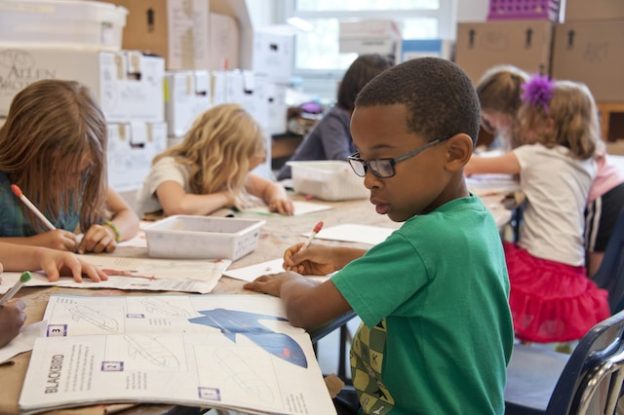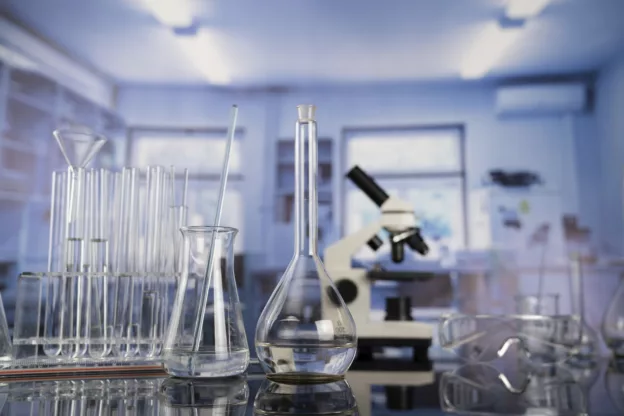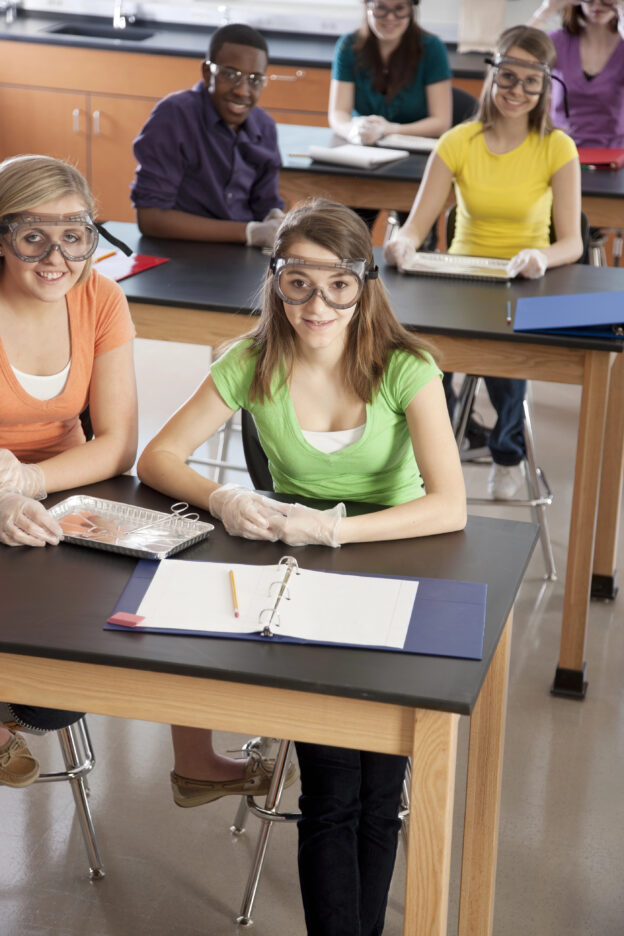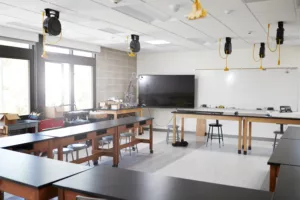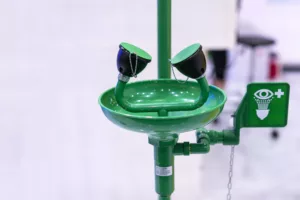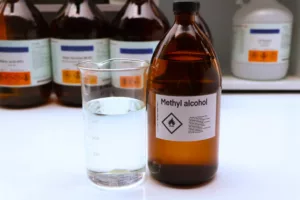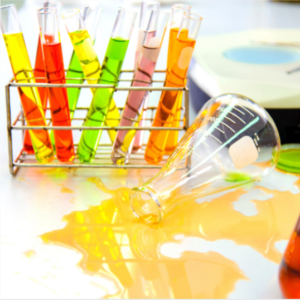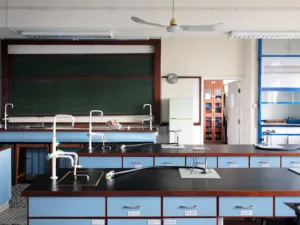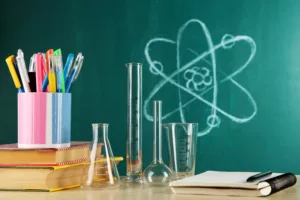M. Ezrailson
Department of Curriculum and Instruction School of Education
University of South Dakota Vermillion, SD 57069
Corresponding author email: cathy.ezrailson@usd.edu
ABSTRACT
The National Safety Council has estimated that 5000 safety-related accidents occur in American schools each year; at least ten per cent of these are science class- room related (Stroud 2009). Moreover, state safety data extracted from research studies spanning 75 years establish school lab safety as a national problem. Clearly, teachers and students, if trained in safe lab procedures, could decrease the risk of injury and death resulting from accidents. Legal standards of care are prescribed to schools with costly consequences for non-observance of these standards. Even so, few school districts implement or monitor OSHA recommendations. According to the Next Generation Science Standards (released in April 2012) and AAAS Benchmarks for Science Literacy (first released in 1993), science courses must provide firsthand hands-on science experiences for students. With this increased number of laboratory experiences, especially in the primary grades, the risk of in- jury increases dramatically. As part of a study to ascertain the science safety readiness of South Dakota schools, in 2009 and 2012, science safety surveys were disseminated to science teachers. Among questions posed were: 1) Is science taught safely through recommended hands-on inquiry methods, and 2) which factors determine if science is being taught safely? In an earlier South Dakota pilot study of classroom teachers statewide, 18% were found not to be specifically certified in science and 85% indicated that they never had formal science safety instruction. These data are typical of results from similar studies in other states that document the severity of the school science safety problem. The purpose of this paper is to examine science lab safety in South Dakota and support a strong recommendation (as OSHA has) that pre-service science teachers (as well as all science teachers already in classrooms) be trained and certified explicitly in safe science procedures before conducting science experiments with students.
Keywords
Science, safety, laboratory accidents science, South Dakota science teacher safety training, K-12 science safety, science safety responsibilities of schools.
INTRODUCTION
The Next Generation Science Standards (NGSS), released in April 2013, endorse student-centered, hands-on methods of inquiry for learning science over traditional lecture-only methods An increase in the number of lab activities increases the risk of accident for students and teachers. Teachers and their students, made aware and trained against safety risks, will be more successful in avoiding accident. Not all mishaps can be prevented, however. Should they occur, teachers and schools must be prepared with an action plan in place in order to minimize injury. Schools are charged with “due diligence” and a well delineated “standard of care” outlined by Occupational Safety and Health Administration (OSHA) recommendations (Stroud et al. 2009). Although several studies show laboratory safety is a growing concern for schools, little national data exist on the current safety of facilities, equipment, and practices (Brazas 2013). Further, school administrators and science teachers, who bear the responsibility for student safety, appear to receive little systematic safety training (Singer, Hilton and Schweingruber 2005). Although, according to the South Dakota Science Safety Survey, many attempt to gain safety expertise on their own.
Science teachers must know and apply the requisite regulation for storage, use and care of materials used by students in the classroom. They are also charged with following safety rules and mandates established by regulating bodies such as OSHA, the National Science Teachers Association (NSTA) and the American Chemical Society (ACS) as well as state and local regulating agencies. Administrators and teachers must work together to take an active role in working with their district and state to make sure that every science lab and classroom is equipped with required safety equipment.
According to America’s Lab Report (Singer et al. 2005), teachers’ responsibilities include:
The duty of instruction. Teachers must instruct students prior to any laboratory activity, providing accurate, appropriate information about foreseeable dangers; identifying and clarifying any specific risks; explaining proper procedures/ techniques; and describing appropriate behavior in the lab. These instructions must follow professional and district guidelines.
The duty of supervision. This includes not tolerating misbehavior, providing greater supervision in more dangerous situations, providing greater supervision to younger students and those with special needs, and never leaving students unattended.
The duty of maintenance. This requires that the teacher never use defective equipment, always file written reports for maintenance or correction of hazardous conditions or defective equipment, establish regular inspections of safety equipment and procedures, and follow all guidelines for handling and disposing of chemicals.
Unfortunately, these regulations are rarely adhered to which may be due to lack of funds and awareness.
Courts have ruled that if teachers fail to properly supervise or instruct a class in safety procedures, responsibility for injuries may fall on the teacher. It is therefore imperative that teachers be well trained in proper procedures. Districts have a responsibility to provide this training before teachers perform lab science with students. Teachers must always weigh educational value versus possible accident risk in deciding what type of laboratory investigations to conduct. Finally, according to NSTA, science experiments must be appropriate for the type of classroom, size of classroom and ages of the students.
METHODS OF STUDY
In early 2008, supported by a South Dakota Board of Regent’s Seed Grant at the University of South Dakota, I undertook a pilot study (n=30) of classroom safety practice. Its purpose was to determine whether South Dakota teachers who taught science at all levels experienced similar safety issues as were faced by teachers in other states, to identify those issues and to recommend how to address them. Also examined was the status of classroom science safety training and practice in South Dakota schools. The results of this study were to be used in the design of a training program in science safety for pre- and in-service teachers. The assumption was that accidents would be reduced once teachers were trained in science lab safety. (Ezrailson et al. 2008).
On the basis of the pilot survey, a follow-up survey was constructed, inter- rater reliability was established and a wider cross-section of science teachers was then surveyed (n=92) late in 2008. The 25-question Science Safety Survey was disseminated through the South Dakota Department of Education science teacher listserv. This survey can be found in Appendix II.
Although submitted to the South Dakota Department of Education in December 2011, the Science Safety Survey 2 was disseminated in January 2012. The intent of the re-dissemination of the survey was to ascertain if the climate of science safety in schools had changed (96 participants responded to the 2012 survey). A comparison between the data from the 2009 and 2012 surveys was to discern and highlight persistent school science safety issues.
The research questions examined for this study were:
- Are South Dakota teachers aware of proper (and safe) practices (as outlined in the NSTA Guidelines) when teaching science?
- Are South Dakota teachers trained in safe science practice?
- What are the key safety issues facing the South Dakota teacher who teaches science? How does this vary by grade level?
- To what extent do teachers apply safe practices when teaching science in their classrooms?
Highlighted in Appendix I is also a concordance between science safety language in the South Dakota Science Content Standards and the accepted “best practice” for science safety procedures used in classrooms as outlined by NSTA and the Council of State Science Supervisors (Comer 2000). This concordance established that gaps existed between what is commonly accepted as safe science practice and the wording in the South Dakota state science standards that guide the teaching of science for K-12 teachers.
South Dakota Science Survey questions consisted of multiple choice questions that were open-ended, and logistics questions. Three specific science safety scenarios were also included. These scenarios asked respondents to judge a science safety situation and make decisions based on their training and experience.
RESULTS: SURVEY DATA
Participants responding to the 2009 survey included 8.7% PreK-2nd grade teachers, 6.5% 3rd -5th grade teachers, 29% 6-8th grade teachers and 54% high school teachers with one administrator who also taught. In the 2012 survey, participants included 0% PreK-2nd grade teachers, 3.1% 3rd -5th grade teachers, 23% 6-8th grade teachers and 74% high school teachers.
Responses to the 2009 survey indicated that 14 teachers had taught 0-5 years, 10 had taught 6-10 years, 36 teachers had taught 11-25 years and 23 teachers had taught more than 25 years. In the 2012 survey, 14 teachers had taught 0-5 years, 18 had taught 6-10 years, 42 teachers had taught 11-25 years and 22 teachers had taught more than 25 years.
According to the survey data, few teachers had any formal training in science lab safety before beginning to teach science in South Dakota. Results from the initial pilot survey had found that almost 18% of the responding teachers indicated that they were not certified in science. In the wider studies conducted in the fall of 2008 and early 2012, 35% of respondents had general K-8 certification (survey question 8) not indicating a specialty in science. In the 2012 survey, 20% of respondents were K-8 generalists. Several additional issues were examined including the structure of the classroom, whether science safety was also taught to students, how long the respondents had been in the classroom and responses to two fictional science lab emergency scenarios.
In Table 1 is a comparison of the profiles of the respondents’ lab situations. In the 2009 survey (Table 1A), 65% of respondents had a lab area compared with 76% of respondents to the 2012 survey (Table 1B). Conversely, in 2009, 26% did the best that they could with a less than ideal classroom situation. In 2012, 21% were challenged with teaching in this situation.
Table 1. Question 10: Survey respondents’ lab areas 2009 and 2012.
2009
| Answer Choices | % | # |
| a) I have a lab area | 65 | 55 |
| b) I use a different classroom or area in the building to conduct science activities | 3.2 | 8 |
| c) I am unable to conduct science experiments because my class lacks ascience area | 1.2 | 1 |
| d) I do the best I can with my situation – I describe my situation below | 26 | 22 |
2012
| Answer Choices | % | # |
| a) I have a lab area | 76 | 70 |
| b) I use a different classroom or area in the building to conduct science activities | 9.5 | 3 |
| c) I am unable to conduct science experiments because my class lacks ascience area | 0 | 0 |
| d) I do the best I can with my situation – I describe my situation below | 21 | 19 |
In 2009, 29 percent of respondents indicated that they administered a science lab safety test to their students (Table 2A, question 10 from the survey). In 2012, an excess of 49 percent had administered a science lab safety test (Table 2B). According to respondents’ comments, the middle range shown indicates teachers who did not always administer a lab safety test prior to instruction, did not administer a formal test or gave safety instruction in another manner, such a verbally before a lab was conducted.
Table 2. Question 13: Survey respondents’ safety instruction for students 2009 and 2012.
| 2A. 2009 | 1- Least like my situation | 2 | 3 | 4 | 5 | 6 | 7 – Most like my situation |
| My students take a science lab safety quiz prior to instruction | 42% | 11% | 7.1% | 3.5% | 2.4% | 4.7% | 29% |
| Number | 36 | 9 | 6 | 3 | 2 | 4 | 25 |
| 2B. 2012 | 1- Least like my situation | 2 | 3 | 4 | 5 | 6 | 7 – Most like my situation |
| My students take a science lab safety quiz prior to instruction | 13% | 12% | 4.3% | 5.4% | 8.6% | 7.5% | 49% |
| Number | 12 | 11 | 4 | 5 | 8 | 7 | 48 |
Participant comments in the 2009 survey (Table 3A) gave further evidence of the dearth of science lab safety training programs participated in by respondents. Alternative measures mentioned in the comments were exploration of safety materials online, safety mentioned in college science courses, experience with safety issues in previous occupations and word of mouth from other teachers.
The following were some typical statements from respondents: “I have handled some safety equipment…but I haven’t been trained on specific procedures.” “Some [safety] concerns have been covered in classes I’ve taken but nothing has specifically been in a class on science safety.”
In the 2012 survey (Table 3B), similar comments were presented, for example: “No formal course, only the general training given in each lab during college.” “I had basic training, but not a specific course in college, however. I have only received informal training since then all based on my own need and interest.”
Table 3. Question 15: Profile of Respondents’ Formal Safety Training
| 3A. 2009 | 1- Least like my situation | 2 | 3 | 4 | 5 | 6 | 7 – Most like my situation |
| As the teacher, my training in science safety includes a formal course or other training | 40% | 19% | 13% | 12% | 3.5% | 5.9% | 7.1% |
| Number | 34 | 16 | 11 | 10 | 3 | 5 | 6 |
| 3B. 2012 | 1- Least like my situation | 2 | 3 | 4 | 5 | 6 | 7 – Most like my situation |
| As the teacher, my training in science safety includes a formal course or other training | 43% | 11% | 11% | 12% | 8.7% | 5.4% | 8.7% |
| Number | 34 | 16 | 11 | 10 | 3 | 5 | 8 |
Three emergency science lab scenarios were posed to respondents in each of the 2009 and 2012 surveys. The first scenario (Question 22 on the survey) with responses are given below:
Several responses involved the teacher taking action to put out the fire rather than evacuation of the classroom and pulling the fire alarm because chemical fumes can be overwhelming in a closed space without good ventilation. One 2009 respondent had had prior training and knew the important steps to follow: “The proper procedure with any fire is to Rescue, Alert, Contain, Extinguish (RACE). Students must be rescued first. Then extinguish the fire.”
A 2012 respondent would react first: “Reality – I’d probably grab the fire extinguisher if the flames were out of control. If the burning produces a clean flame and isn’t going to quickly damage the table, “I” would probably be more likely to try and scoot the mothballs in a sink with tongs or something, rather than making a mess with the extinguisher.”
The second scenario in the survey (Question 23) states:
Several responses referred to actions that should have been taken before the lab or put the onus on the student. Only a few expressed how they would deal directly with the situation. For example, one 2009 respondent suggested: “… Let’s not forget Sam’s parents for not teaching him to keep his hands/fingers out of his eyes ALWAYS…not just in bio class. The teacher should ALWAYS discuss safety. Laying of blame is not applicable and counter productive.” And, a 2012 respondent voiced concerns of several respondents when he stated that the “Student should have told the teacher about his itchy eyes before leaving the classroom.”
The third scenario in the survey (Question 24) sets up the following situation:
Some of the respondents indicated in their comments that they would flush the burns with water or summon the nurse. Typical comments were as follows: A 2009 respondent would “Have students leave the room. Call the office, next door for help.” A 2012 respondent explained, “I don’t know how to handle this because I don’t do this lab. If I did I would need to find out how to protect students if an accident occurred.”
The South Dakota Safety Study results indicate that teachers may not typically and specifically be trained in safe classroom science methods or equipment. In the 2009 survey, only 7.1% of respondents said that they had participated in
science safety training either formally or informally (Table 3A, survey question 15). By 2012, that number had risen only to 8.7% (Table 3B).
DISCUSSION: SOUTH DAKOTA IS NOT ALONE
Laboratory investigations are essential for the effective teaching and learning of science. A school laboratory investigation (“lab”) is an experience in the laboratory, classroom, or the field that provides students with opportunities to interact directly with natural phenomena or with data collected by others using tools, materials, data collection techniques, and models (Singer et al. 2005). Inherent in laboratory-based activities is the potential for injury. As professionals, teachers of science have a duty of care to ensure the safety of students, teachers, and staff. Duty of care is defined as an obligation, recognized by law, requiring conformance to a certain standard of conduct to protect others against unreasonable risk. “The breach of a particular duty owed to a student or others may lead to liability for both the teacher and the school district that employs that teacher.” (Ryan 2001). As such, science educators must act as a reasonably prudent per- son would in providing and maintaining a safe learning environment for their students (National Science Teachers Association 2007).
The results of the South Dakota Science Safety Survey suggest that although many teachers may be aware of some basic safety issues, a consistent statewide K-12 teacher safety program does not exist in South Dakota at this time. Many piecemeal efforts produce gaps in the school science safety expertise of teachers and introduce an atmosphere of risk and liability for school districts, teachers and administrators in South Dakota. Research into studies conducted in other states highlight a national problem.
Unfortunately, national and state incident report data are not readily available. No national repository of information on school science accidents exists. What data there are have typically been gathered by individual states, public entities or researchers, which make a nationwide study difficult but vital as this issue affects every community and school. Although government agencies, states, school districts, and professional associations make efforts to notify schools about safety policies and practices, evidence suggests that schools tend to react to accidents when they occur rather than taking preventative action to avoid them. Many regulations in place are commonly ignored.
The costs of adequate safety can be very large. For example, between 2000 and 2003, the Chicago Public Schools spent $570,000 to conduct chemical sweeps in schools, at a cost of approximately $2,600 per school. Even though preventive safety measures are expensive, the costs of accidents and injuries may be even larger (Singer et al. 2005). The lack of publicly available data on laboratory accidents and injuries may be due in part to the fact that many legal cases are settled before trial. As a result, there are few articles discussing legal precedents and findings in cases related to laboratory science (Standler 1999).
A survey of the research into school science accidents revealed the findings listed in Table 4.
Table 4. Supporting studies in laboratory safety.
| Research Group | Scope/Data | Findings/Conclusions |
| National Science Teachers Association (NSTA) | 302 secondary science teachers in 47 states and 3 territories. Questions included school science facilities, science equipment, procedures used in teaching science. | Very serious safety concerns.Teachers unaware of applicable laws, codes, and standards and uninformed about safety issues and procedures. Many labs and storerooms were sub- standard or inadequate; chemicals (e.g., mercury, sodium and potassium) and other equipment had never been inventoried cataloged or stored to reduce accidents (Gerlovich and Parsa 2002). |
| Federal Agency for Toxic Substances and Disease Registry (ATSDR) | 423 chemical incidents re- ported nationwide in public schools during 2002-2007 895 people were injured in the incidents | Improper and unsafe chemical storage/ use of materials or equipment (Stroud, 2009) |
| New Jersey Science Supervisors Association | 102 New Jersey secondary school science teachers 4,721 accidentsThirty-seven percent of respondents reported a major accident had occurred during their teaching career. | Teachers with more education and experience had significantly fewer accidents.Lab facilities had inadequate eye protection (Krajkovitch 1982). |
| Texas State Science Teachers Association (CAST Meeting and 12 laboratory safety professional development sessions) | 590 respondents36 percent of respondents reported a total of 460 minor laboratory accidents in one school year | Facilities on average were smaller than the size recommended by NSTA.Texas Hazard Communications Act requires all science teachers new to a school to participate in professional development focused on laboratory safety, but only 33 percent of respondents indicated that they had done so (Stephenson et al. 2003). |
| Hong Kong Ministry of Education | 401 secondary schools, 29% of which reported injuries during 2011-2012348 students and four staff persons injured | Laboratory accidents revealed that school science safety is a worldwide issue (Ministry of Education 2011). |
These studies and surveys add weight to the argument that strongly recommends (as OSHA requires) that all K-12 teachers of science be trained and certified explicitly in safe science procedures before being allowed to conduct science experiments in the classroom with students. NSTA guidelines for preparing science teachers emphasize competent science safety knowledge and recommend that teachers should model science safety procedures, training students explicitly during instruction — not leaving this important issue to chance (National Science Teachers Association 2003).
Additional data indicate that large class sizes may pose a threat to safety in school laboratories. Average science class size in California, for example, was
30.1 students per teacher in the 2003-2004 school year and that exceeds the NSTA standard of 24 students per teacher in science classes conducting science
experiments. It may be extremely difficult for teachers in classes of 30 students to perform the “duty of supervision” and maintain safety during laboratory experiences (Stephenson et al. 2003). Data from a Texas study indicated that accidents occurred frequently, although most were minor and involved cuts and minor burns; however, many were more serious and resulted in severe injury to students and teachers. Most occurred during student hands-on activities or when students performed experiments in the lab or classroom (Stephenson et al 2003).
The data suggest that safety in the science classroom and lab can no longer be ignored. Better training in laboratory safety can provide information that helps schools and teachers enforce legal requirements for maintaining student safety. More organized and explicit professional development is required in order to create uniform and lasting changes in science safety methods coincident with the sustained professional development, which supports changes in teaching practices.
CONCLUSION: IMPLEMENTING SAFE SCIENCE
Although clearly in some cases, science is being taught in safe environments where teachers are well informed and trained in safe use of equipment and materials, all too often, however, the opposite is true. Safety instruction provided to teachers, no matter how they may have been educated and certified is rarely consistent, explicit or in-depth (Stroud 2009). Safety practices in the classroom are too important for the health and welfare of students to be left to happenstance. Safe science procedures should always be taught explicitly and completely to all pre-service and in-service teachers as well as their students.
The Council of State Science Supervisors provides a comprehensive and practical guide for teachers and students appropriate for teachers in K- 5 classroom situations. NSTA, through its website, web seminars and journals, The Science Teacher, Science Scope and Science and Children, provides many safety resources, videos and articles important to science teachers K-12. In addition, NSTA is- sued a Position Statement on the Liability of Science Educators for Laboratory Safety in 2003, which clearly states the responsibilities of teachers relative to science safety (National Science Teachers Association 2003). The full text of the position statement can be found on the NSTA web site.
Facilities are another place to start. Several studies have documented that the smaller the lab space and the larger the class, the higher the risk for accidents (National Science Teachers Association 2003; Stephenson et al. 2003). The National Science Teachers Association (2003) has called for a minimum of 45 square feet per student for a standalone laboratory and 60 square feet per student for a combination laboratory-classroom. This translates into at least 1,250 square feet for a laboratory and 1,440 square feet for a combined laboratory classroom and recommends a maximum class size of 24 students in high school laboratory science classes.
OSHA has established standards of care to protect the health and safety of all employees, including teachers and staff. One of the most important OSHA standards of care for school laboratories is the Laboratory Standard (29 CFR1910.1450). This standard requires school science teachers to create and maintain a chemical hygiene plan (CHP). In most schools, a science teacher or teachers develop this CHP, which outlines policies, procedures, and responsibilities to increase student, teacher, and staff awareness of potentially harmful chemicals. The CHP requires proper labeling of all chemicals, and the maintenance of Material Safety Data Sheets which outline important safety information, and safe storage of chemicals. These data sheets must be made available to school employees and must be kept in a safe but easily accessible location. The National Institute for Occupational Safety and Health provides guides for proper separation of incompatible chemical families (Wattigney 2008).
The U.S. Environmental Protection Agency (EPA) also administers several laws and regulations affecting safety in high school science laboratories. These include (1) the Resource Conservation and Recovery Act, (2) the Emergency Planning and Right-to-Know laws and regulations, and (3) the Toxic Substances Control Act. To carry out provisions of the Resource Conservation and Recovery Act, EPA issues regulations and guidelines governing safe storage of laboratory chemicals, equipment, and supplies. Title III of this act governs emergency planning and right-to-know (about potentially hazardous chemicals), and Title IV governs chemical disposal related specifically to school science laboratories (Wattigney et al. 2008).
A few practical measures can prevent most school lab accidents and go a long way to inform schools. These measures include:
- The creation of a national database of science safety best practice
- A published set of uniform, sustained and tested science safety training programs for teachers, administrators and state officials
- A national, organized and consistent effort to infuse the teaching of science with safe practice.
- The will to update poor science facilities, unsafe equipment and
- The disposal of dangerous chemicals in aging science storerooms in
An immediate call to action is imperative in order to rectify this under-examined and overdue national public health problem. Because educators have a duty to maintain a safe learning environment while providing science instruction, this duty must also be shared equally among school leaders, district administrators, school boards, parents, and students themselves. This is an urgent issue — teachers and administrators must communicate regularly and fully on the essentials of safe instruction for students that reflect the latest research on classroom size, safe use of equipment and safety training.
The reality of science in schools is this: appropriate scientific instruction should always include providing students the opportunity to actively engage in scientific investigations. But, if teachers lack training and confidence in their knowledge of science safety, are unsure of how to manage science experiments, and administrators are no more knowledgeable than their teachers, then students will be at risk and fewer recommended hands-on and inquiry-based science activities will be done in primary and secondary classrooms. Thus, another generation of American students would miss out on science experiences that would produce a more scientifically literate populace.
LITERATURE CITED
American Association for the Advancement of Science. 1993. Benchmarks for Science Literacy Available from http://www.project2061.org/publications/bsl/online/index.php [Cited 4/4/13].
Brazas, S. 2013 . Liability for School Science Experiment Accidents, Law Info. Available from https://www.researchgate.net/publication/262419708_Danger_in_the_School_Science_Lab [Cited 3/3/13].
Comer, C. 2000. Science and Safety Making the Connection. The Council of State Science Supervisors, Virginia.
Everett J. S., R. Axelrad, W.A.Wattigney. 2006. Healthy and safe school environment, part II, physical school environment: results from the School Health Policies and Programs Study Journal of School Health (77):544-56.
Ezrailson, C.M. 2009. Report: Evaluating Safe Science Teaching Practice in the U.S. (Phase II). PER ComPADRE Collection. Available from http://www.compadre.org/ per/items/detail.cfm?ID=7521 [Cited 7/23/13].
Ezrailson. C. M., P.G. Millard, and R. Kludt, 2008. Report: A Design and Evaluation Study for Teaching Science Safely in South Dakota Schools. PER ComPADRE. Available from http://www.compadre.org/per/perc/2008/Detail.cfm?id=799 [Cited 7/12/13].
Gerlovich, J. A., D. McElroy, R. Parsa, and B. Wazlaw. 2005. National school science safety indexing project: A beginning. The Science Teacher 72 (6):43–45.
Krajkovitch, J. G. 1983. A Survey of Accidents in the Secondary School Science Laboratory, New Jersey Science Supervisors Association.
National Science Teachers Association. 2003. Position Statement on Science Safety.
Available from http://www.nsta.org:about:positions:safety.aspx [Cited 3/2/13].
Next Generation Science Standards. 2013. Achieve, Inc., Washington, DC. Available at http://www.nextgenscience.org/next-generation-science-standards [Cited 4/19/13].
Ryan, K. 2001. Science Classroom Safety and the Law: A Handbook for Teachers. Flinn Scientific, Inc., Batavia, Il.
Secretary of Education. 2013. Education Bureau Circular Memorandum No.55/2013. Hong Kong Ministry of Education, Available from: http://applications.edb.gov.hk/ circular/upload/EDBCM/EDBCM13055E.pdf [Cited 8/2/13].
Sinclair, L., J. Gerlovich, and R.A. Parsa, R. 2013. South Carolina Statewide Science Safety Project, Journal of the South Carolina Academy of Science: 1:1, 5. Available from: http://scholarcommons.sc.edu/jscas/vol1/iss1/5 [Cited 3/15/13]
Singer, S.R., M.L. Hilton, and H. Schweingruber. 2005. America’s lab report: Investigations in high school science, p 186-9. National Academies Press, Washington, D.C. Stroud, LM. 2009. The Science Reflector. Newsletter – North Carolina Sci. Teach. Assoc.
Stroud, L.M., and K. Roy. 2009. OSHA Training Requirements and Guidelines for K–14 School Personnel, NSTA.
Stephenson, A.L., S.S. West, J.F. Westerlund, and N.C. Nelson. 2003. An analysis of incident/accident reports from the Texas Secondary School Science Safety Survey, 2001. School Science and Mathematics Journal 103:6.
Wattigney, W.A, M. Stat, M.S. Orr, and G.D. Williamson. 2008. Div of Health Stud- ies, Agency for Toxic Substances and Disease Registry; Jones, S.E., Division of Adolescent and School Health, CDC. 2008, Nov 7. Hazardous Chemical Incidents In Schools—United States 2002-2007. Morbidity and Mortality Weekly Report Weekly, 57(44):1197-1200. CDC.
APPENDIX I. South Dakota Science Safety Standards Concordance.
Safety Statement Found in 2003 SD Science Standards
Students are able to:
Grade Level(s)
Indicator or Content Standard
How Addressed (G**, S***)
| Supporting Skills |
Practice Science Safely* K Indicator 2: G Use safety procedures in conducting science investi- S
gations. 1 Indicator 2:
Example: Explain why food used in an experiment is not for eating….
Recognize importance of safety procedures and
Supporting Skills S
S
equipment. 2 Indicator 2:
Example: Direct projectiles away from peers when flying gliders
Use appropriate scientific equipment and proper safety procedures in all investigations.
Apply the skills necessary to conduct scientific investigations
Describe how designing a solution may have
Supporting Skills S
| 3 |
| G |
Indicator 2: Supporting Skills
| 4 |
| G |
Indicator 2: Supporting Skills
Indicator 1: G
constraints 5
Standard 5.S.1.2.
Example: cost, time, space, materials, and safety G
Describe and demonstrate various safety factors G
associated with different types of scientific activity. 6 Indicator 2:
Example: Use appropriate scientific equipment safely in all investigations.
Describe and demonstrate various safety factors
Standard 6.N.2.1. G
G
associated with different types of scientific activity. 7 Indicator 2:
Example: Demonstrate appropriate use of apparatus and technologies for investigations.
Describe and demonstrate various safety factors
associated with different types of scientific activity. 8
7.N.2.1. G
Indicator 2: G
8.N.2.1.
| G |
Example: Wear appropriate attire. G
Students are able to practice safe and effective laboratory techniques.
Handle hazardous materials properly. G
Use safety equipment correctly. Practice emergency procedure.
Indicator 2: G
| 9 to 12 |
9-12.N.2.2. G
Wear appropriate attire. G
Practice safe behaviors. G
*Note: These skills should be taught and practiced in grade-level study of Physical, Life, and Earth/Space Science although mastery is not expected at K-2 levels.
** GENERAL (G) designation here means no specific step-by-step direction given to students
*** SPECIFIC (S) designation here includes appropriate steps for students to follow.
APPENDIX II. School Science Safety Survey.
- Please give the information indicated Your survey will be assigned a code. No identify- ing information will be associated with survey results. This information is encrypted and cannot be accessed on the web or off.
School District Name City/Town: Zip Code:
- Please select the choice below that best represents your current teaching assignment
PreK-2nd grade 3rd-5th grade 6th-8th grade 9th-12th grade Administrator
- Additional grade levels you have previously (Check all that apply).
PreK-2nd grade 3rd-5th grade 6th-8th grade 9th-12th grade Administrator
- Number of years that I have been teaching
- Number of years that I have taught science
- Subject(s) taught previously include (check all that apply)
Elementary (general) Elementary Science/math Elementary Language Arts/Social studies Physical Science Chemistry Biology Life Science Earth Sci- ence Space Science Technology/Computers Basic Mathematics Advanced Mathematics English/Reading/Literature History/Social Science Fine Arts
Other
- Please indicate the subjects that you currently teach (Check all that apply).
Elementary (general) Elementary Science/math Elementary Language Arts/ Social studies Physical Science Chemistry Biology Life Science Earth Science Space Science Technology/Computers Basic Mathematics Advanced Mathematics English/Reading/Literature History/Social Science
- Teaching Certification
K-8 7-12 other endorsements, please specify:
- Please select the number for the following that most fits your classroom 1 Least like my situation 2 3 4 5 6 7 Most like my situation
In my science classroom, I have a special area dedicated to science activities/demonstrations.
Other – please specify
- If you do have such an area, please mark choice A. If you do not have a special laboratory or science activity area in your classroom where you teach science, please mark the choice below that best describes your situation:
- a) I have a lab
- b) I use a different classroom or area in the school building to conduct science activities/
- c) I am unable to conduct science experiments because my classroom lacks a science area
- d) I do the best I can with my situation (describe my situation below:)
- In the space provided, please write a detailed description of where you conduct science activi- ties/demonstrations and what that area/room/space looks like.
All survey participants should answer the following questions.
- Please select the number that most fits your classroom and science teaching 1 Least true of my situation 2 3 4 5 6 7 Most true of my situation
Science lab safety instruction is more likely to take place in my classroom at the beginning of the school year.
Comments
- Please select the response that most fits your classroom and science teaching 1 Least like my situation 2 3 4 5 6 7 Most like my situation
My students take a science lab safety quiz/test over the science safety instruction. Comments
- Please select the response that most fits your classroom and science teaching 1 Least like my situation 2 3 4 5 6 7 Most like my situation
I have a science safety contract that students and parents sign. Comments
- Please select the response that most fits your classroom and science teaching 1 Least like my situation 2 3 4 5 6 7 Most like my situation
As the teacher, my training in science safety includes a formal course or other training in science safety.
Comments
- Please select the response that most fits your classroom and science teaching 1 Least like my situation 2 3 4 5 6 7 Most like my situation
Safety equipment in my lab is inspected at least once per year. Comments
- Please select the response that most fits your classroom and science teaching 1 Least like my situation 2 3 4 5 6 7 Most like my situation
I always teach science safety in my science classes. Comments
- Please select the response that most fits your classroom and science teaching situation 1 Least like my situation 2 3 4 5 6 7 Most like my situation
I know how to purchase, handle and store science equipment. Comments
- The following safety equipment is available to me when I teach science (select all that apply):
- Safety glasses for each student b) Safety aprons for each student c) Eyewash station d) Fire blanket e) Fire extinguisher f ) Sinks g) Telephone h) MSDS manual i) Safety posters j) Other (please specify)
- I am prepared to handle the following safety concerns when teaching science:
- Allergies (e.g. nuts, latex) b) Light sensitivity c) Odors d) Fire e) Chemical spill f ) Cuts and lacerations f ) Other (please specify)
- I demonstrate the proper use of the following safety equipment and other topics to my class prior to lab activities (select all that apply):
- Fire blanket b) Fire extinguisher c) Eyewash station d) Proper handling of glassware
- e) Wearing proper clothing/shoes in lab f ) Emergency procedures g) Other (please specify)
- Sixth grade science teacher, Mrs. Fitzgerald, is heating mothballs to simulate magma. She is heating a test tube under an open flame. The glass tube cracks and the mothballs fall into the flame, and catch fire. If you were Mrs. Fitzgerald, what is the first thing you would do in this situation? a) Run to the phone and call the janitor for help b) Grab the fire extinguisher and make sure all the flames are out c) Ask students to help put out the fire d. Other (please explain
- Smith’s class is learning about amphibian anatomy by dissecting frogs. Dr. Smith briefly demonstrates to the class what they will be doing but does not explain safe procedures to his class. Students are then instructed to go to their lab benches and begin dissecting. After a half hour, Sam, a student in Dr. Smith’s class notices that his eyes are starting to itch. He puts his fin- gers to his face and rubs his eyes. Sam’s eyes continue to itch and become more irritated through- out the lab period. However, Sam leaves class without mentioning anything to Dr. Smith. When Sam gets home from school his mother notices how red his eyes are and that he is constantly rubbing them. She asks Sam what he did at school, and Sam tells her they dissected frogs in science class. Sam is taken to the doctor and they discover that Sam must have gotten formalde- hyde in his eyes when he rubbed them during class.
Who is responsible for the outcome of the student injury?
a) The student for not taking care in lab b) The teacher for failing to give proper safety instruction c) The manufacturer of the dissecting specimen d) other, please specify
- Science teacher, Mr. Scott, is making soap with his students and accidently added too much lye to the mix, which caused some of the students to experience chemical If you were Mr. Scott, what is the first thing you would do in this situation?
- Soak the burn or rinse off the chemical as soon as possible b) Leave the classroom to get help
- c) Put ice water directly on the burn Other (please specify)


